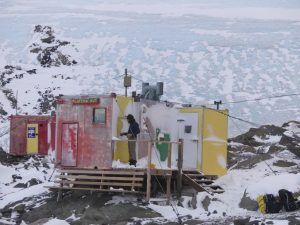 It’s a real shame! Six people visited Platcha Hut, a brand “New One” for many Antarctic Hunters, and nobody brought an HF Radio, to operate a little while from there, and living us the pleasure to log a rare spot in Antarctica!
It’s a real shame! Six people visited Platcha Hut, a brand “New One” for many Antarctic Hunters, and nobody brought an HF Radio, to operate a little while from there, and living us the pleasure to log a rare spot in Antarctica!
We just read the info posted today on FB page: «That’s one way to get to work! Expeditioners from Davis Research Station flew out to check in on the isolated Platcha Hut last week. The team of six got a lift from a helicopter that is currently at the station and had one of the most unique morning commutes in the AAP! »
There are a number of features close to Davis Station (WAP AUS-Ø3) which are the subject of regular recreational visits. These include Lake Dingle and Lake Stinear, the lakes nearest to the Station, Tarbuck Crag as the nearest high point, Weddell Arm for viewing Weddell Seals when appropriate, Ellis Rapids and Brookes Hut. Other field huts within the area, which are regularly used for recreational as well as scientific purposes are Platcha, Bandits, and Watts Lake Huts.
 Platcha Hut 68° 30′ 47″ South, 78° 30′ 36″ East is situated in an extemely handy spot at the base of the plateau just to the south of Breid Basin a few metres above the shoreline. The locale is easy to reach by helicopter in the summer and is a decent walk over rough terrain from Davis Station for the keen. In the winter, Platcha Hut is one of the first to be visited once the sea ice forms and is thick enough. From Davis quads or Hägglunds, head along a waypointed route that follows Long Fjord to Breid Basin. The Hut itself sleeps four in bunk beds with room for two in the recently renovated (2011) Met Hut (the original Platcha) at the back.
Platcha Hut 68° 30′ 47″ South, 78° 30′ 36″ East is situated in an extemely handy spot at the base of the plateau just to the south of Breid Basin a few metres above the shoreline. The locale is easy to reach by helicopter in the summer and is a decent walk over rough terrain from Davis Station for the keen. In the winter, Platcha Hut is one of the first to be visited once the sea ice forms and is thick enough. From Davis quads or Hägglunds, head along a waypointed route that follows Long Fjord to Breid Basin. The Hut itself sleeps four in bunk beds with room for two in the recently renovated (2011) Met Hut (the original Platcha) at the back.
In the early 60s the original Hut was manned continuously by teams of two for a few weeks at a time. They were tasked with making meteorological observations.
 The present Platcha Hut was built in 1982. On the 9th of September the internal fit-out was transported to Platcha and by the 16th of September the hut was completed and ready for occupation which was a mammoth effort by the wintering team of 1982.
The present Platcha Hut was built in 1982. On the 9th of September the internal fit-out was transported to Platcha and by the 16th of September the hut was completed and ready for occupation which was a mammoth effort by the wintering team of 1982.
Thanks and credit to: Field huts around Davis – Australian Antarctic Program (antarctica.gov.au)
There are lots of Antarctic Hunters all over the world, who would love to work for the fist time on air Platcha Hut and for sure the other Huts scattered around the main Scientific bases in Antarctica.
From these pages, we, Radioamateurs launch an appeal to those responsible for scientific activities in Antarctica: Bringing a radio, setting up a couple of dipoles and doing a few hours of activity on HF is not just fun or recreation, but the study of radioionospheric propagation which could be part of the list of scientific experiments. Thank you
